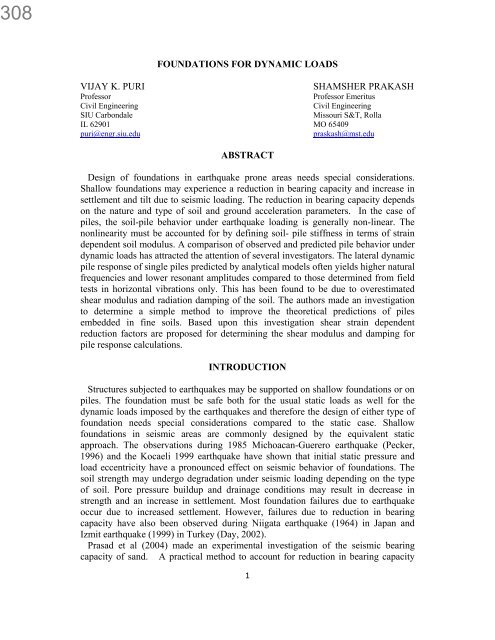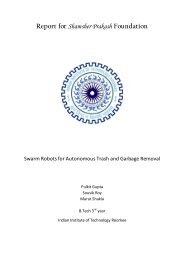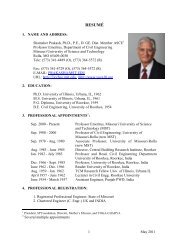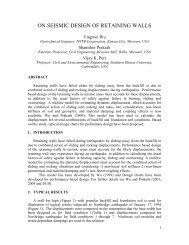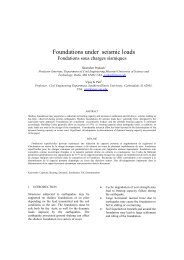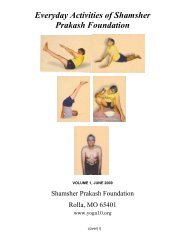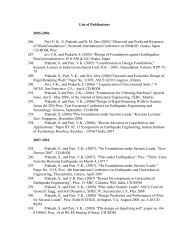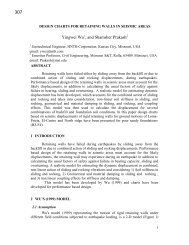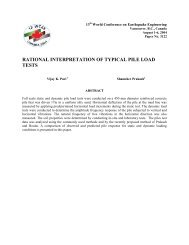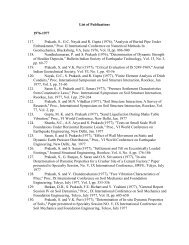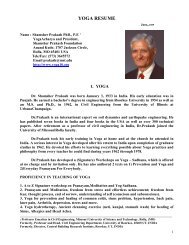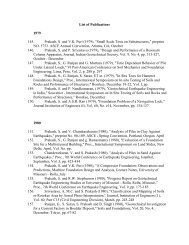Foundations for Dynamic Loads - Shamsher Prakash Foundation
Foundations for Dynamic Loads - Shamsher Prakash Foundation
Foundations for Dynamic Loads - Shamsher Prakash Foundation
You also want an ePaper? Increase the reach of your titles
YUMPU automatically turns print PDFs into web optimized ePapers that Google loves.
due to earthquake loading was presented by Richard et al, (1993). The settlement andtilt of the foundation must also be considered. Gazetas and Anastasopoulos (2008)have studied the interaction effects of two adjacent buildings, founded on shallowfootings.For analysis and design of piles and pile groups under seismic loads a simpleapproach to account <strong>for</strong> nonlinear soil-pile interaction using strain dependent soilmodulus to define soil-pile stiffness and radiation damping can be used and isdiscussed in the paper. Some studies are available comparing the predicted andobserved response of piles also. In some of these studies the soil pile stiffness anddamping were arbitrarily modified to match the observed and predicted response ofthe soil pile system. A study was conducted under the supervision of the authors inwhich the data reported in literature was reanalyzed and reduction factors have beenproposed <strong>for</strong> the stiffness and radiation damping obtained by using the commonlyapproach of Novak and El-Sharnouby (1983). Using the proposed reduction factorsthe reported test data of Gle (1981) was reanalyzed. The predicted values of naturalfrequency and amplitude of vibration at various frequencies showed an excellentgeotechnical comparison with the observed data. The case of shallow foundations isdiscussed first followed by several aspects of pile behavior under dynamic loads.SHALLOW FOUNDATIONSThe problem of static bearing capacity of shallow foundations has been extensivelystudied in the past (Terzaghi (1943), Meyerhoff (1951), Vesic (1973) and manyothers. Basavanna et al. (1974) obtained analytical solutions <strong>for</strong> the bearing capacityunder transient loading conditions. The design of foundations subjected to seismicloading has generally been per<strong>for</strong>med by using psedo-static approach (<strong>Prakash</strong>;1981). The foundations are considered as eccentrically loaded and the ultimatebearing capacity is accordingly estimated. <strong>Prakash</strong> and Saran (1971) proposed amethod to determine the settlement and tilt of a foundation subjected to vertical loadand moment. The response of a footing to dynamic loads is affected by the (1) natureand magnitude of dynamic loads, (2) number of pulses and (3) the strain rate responseof soil. To account <strong>for</strong> the effect of dynamic nature of the load, the bearing capacityfactors are determined by using dynamic angle of internal friction which is taken as2-degrees less than its static value (Das, 1992). Building codes such as InternationalBuilding Code (2006) generally permit an increase of 33 % in allowable bearingcapacity when earthquake loads in addition to static loads are used in design of thefoundation. This recommendation is based on the assumption that the allowablebearing pressure has adequate factor of safety <strong>for</strong> the static loads and a lower factorof safety may be accepted <strong>for</strong> earthquake loads. This recommendation may bereasonable <strong>for</strong> dense granular soils, stiff to very stiff clays or hard bedrocks but is notapplicable <strong>for</strong> friable rock, loose soils susceptible to liquefaction or pore waterpressure increase, sensitive clays or clays likely to undergo plastic flow (Day, 2006).Richards et al (1993) observed seismic settlements of foundations on partiallysaturated dense or compacted soils. These settlements were not associated withliquefaction or densification and could be easily explained in terms of seismic bearing2
capacity reduction. They have proposed a simplified approach to estimate thedynamic bearing capacity q ue and seismic settlement S Eq of a strip footingFigure 1. Failure surface in soil <strong>for</strong> seismic bearing capacity (After Richards etal, 1993; See also <strong>Prakash</strong> and Puri, 2008)Figure 1 shows the assumed failure surfaces. The seismic bearing capacity(q uE ) is given by Eq. 1:q uE = cN cE + qN qE + ½ γ BN γE (1)where, γ = Unit weight of soilD f = Depth of the foundation and q= γD fN cE , N qE , and N γE = Seismic bearing capacity factors which are functions of φ andtanψ = k h / (1-k v )k h and k v are the horizontal and vertical coefficients of acceleration due toearthquake.For static case, k h = k v , = 0 and Eq. (1) becomesq u = cN c + qN q + ½ γBN γ (2)in which N c , N q and N γ are the static bearing capacity factors. Figure 2 shows plots ofN γE /N γ , N qE /N q and N cE /N c with tan ψ and φ.tanψ = k h / (1-k v ) tan ψ = k h / (1-k v ), tanψ = k h / (1-k v ),Figure 2. Variation of N qE /N q , N γE /N γ and N cE /N c with φ and tan ψ (AfterRichard et al 1993; See also <strong>Prakash</strong> and Puri, 2008)SEISMIC SETTLEMENT OF FOUNDATIONBearing capacity-related seismic settlement takes place when the ratio k h /(1 - k v )reaches a critical value (k h /1 – k v )*. If k v = 0, then (k h /1 - k v )* becomes equal to k h * .Figure 3 shows the variation of k h * (<strong>for</strong> k v = c = 0; granular soil) with the static factor3
of safety (FS) applied to the ultimate bearing capacity [Eq, (2)], <strong>for</strong> φ = 10°, 20°, 30°,and 40° and D f /B of 0, 0.25, 0.5 and 1.0.Figure 3. Critical accelerationand Puri, 2008)*kh(After Richards et al, 1993; See also <strong>Prakash</strong>The settlement (S Eq ) of a strip foundation due to an earthquake can be estimated as2 − 4V kS ( m ) 0.174h*Eqtan α AEAg A= (3)where V = peak velocity <strong>for</strong> the design earthquake (m/sec),A = accelerationcoefficient <strong>for</strong> the design earthquake, g = acceleration due to gravity (9.81 m/sec 2 ).tan α AE depends on φ and k h *, (Richards et al, (1993). In Figure 4, variation of tanα AE with k h * <strong>for</strong> φ of 15° - 40° is shown.Suppose a typical strip foundation is supported on a sandy soil with B = 2 m, and D f= 0.5 m, and γ = 18 KN/m 3 , φ = 34°, and c = 0. The value of k h = 0.3 and k v = 0 andthe velocity V induced by the design earthquake is 0.4 m/sec. The static ultimatebearing capacity <strong>for</strong> this footing <strong>for</strong> vertical load will be 1,000 KN/m 2 (Eq. 2). Thereduced ultimate bearing capacity <strong>for</strong> vertical load is calculated as 290 KN/m 2 (Eq 1).If the footing is designed using a FS = 3 on the static ultimate bearing capacity (i.e.,<strong>for</strong> an allowable soil pressure of 333 kN/m 2 ), the additional settlement due toearthquake will be 20.5 mm (Eq 3, Richards et al, 1993). This settlement reduces to7.0 mm if FS of 4 is used. Besides ensuring that the footing soil system does notexperience a bearing capacity failure or undergo excessive settlement, thefoundations should be tied together using interconnecting beams.Seismic bearing capacity factors <strong>for</strong> a strip footing resting on cohesionless soil weredetermined by Dormieux and Pecker (1995) using the upper bound theorem of yield.4
Figure 4. Variation of tan α AE with k h * and φ (After Richards et al 1993; Seealso <strong>Prakash</strong> and Puri, 2008)Using the classical Prandtl like mechanism, it was established that the reduction inbearing capacity was mainly caused by load inclination (Dormieux andPecker;1995).Choudhury and Subba Rao (2005) determined seismic bearing capacityfactors <strong>for</strong> shallow strip footing using the limit equilibrium approach and pseudostaticmethod of analysis. The reduction in bearing capacity under the combinedeffect of vertical and horizontal <strong>for</strong>ces was explained by using smaller failure surfacecompared to case when only static vertical loads are applied.It is thus seen that presently (2009), the pseudo-static approach is being used todetermine bearing capacity and settlement and tilt of the foundations subjected toseismic loads in non-liquefying soils. <strong>Dynamic</strong> nature of the load and other factorswhich affect the dynamic response are not being accounted <strong>for</strong>. Also, no guidelinesare available design of footings in liquefying soil.PILES FOUNDATIONSPiles may often be the preferred choice of foundations in seismic areas. The seismicloading induces large displacements or strains in the soil. The shear modulus of thesoil degrades and damping (material) increases with increasing strain. The stiffness ofpiles should be determined <strong>for</strong> these strain effects. The elastic solutions <strong>for</strong>determining response of piles subjected to dynamic loads have been presented byseveral investigators in the past in several modes of vibrations, (Novak, 1974; Novakand El-Sharnouby, 1983; Novak and Howell, 1977; Poulos, 1971; <strong>Prakash</strong> andPuri,1988; and <strong>Prakash</strong> and Sharma, 1991). Displacement dependent spring anddamping factors <strong>for</strong> piles <strong>for</strong> vertical, horizontal and rotational vibrations have beenpresented by Munaf and <strong>Prakash</strong> (2002), Munaf et al. (2003) and <strong>Prakash</strong> and Puri(2008). The stiffness of the pile group is estimated from that of the single piles by5
using group interaction factors. The contribution of the pile cap, if any, is alsoincluded. The response of the single pile or pile groups may then be determined usingprinciples of structural dynamics. The design of pile foundations subjected toearthquakes requires a reliable method of calculating the effects of earthquakeshaking and post-liquefaction displacements on pile foundations. Keys to good designinclude reliable estimates of environmental loads, realistic assessments of pile headfixity, and a mathematical model which can adequately account <strong>for</strong> all significantfactors that affect the response of the pile-soil-structure system to ground shakingand/or lateral spreading in a given situation.The equivalent spring stiffness and damping of the soil-pile system are a function ofYoung’s modulus of pile material (E p ), shear modulus of soil (G s ), and geometry ofthe piles in the group. Shear modulus and hence spring and damping factors are strainor displacement dependent. There are six independent spring factors <strong>for</strong> a piles-capsystem; ie; k x , k y , k z , in translation in x, y and z directions, respectively and k φ , k θ , k ψrotational-springs about x, y and z directions respectively. There are two rotationalcross-coupled springs; i.e.; k xφ and k yθ which include 2-components of displacement;i.e., translation and rotation about the appropriate axis. Also there are correspondingeight damping factors; i.e., c x , c y, c z , c φ , c θ , c ψ , and. c xφ and c yθ . To developdisplacement dependent relationships <strong>for</strong> the spring and damping factors, appropriaterelationships between strain and displacement are needed. Also, modulusdegradation with strain needs be built into these relationships. Stiffness and dampingin all the modes; i.e., vertical, horizontal, rocking and torsion and cross coupling inboth the x and y direction have been evaluated (Munaf and <strong>Prakash</strong>, 2002). The signconvention is explained in Fig. 5.Figure 5: Sign ConventionFor the case of earthquake loads, the response of piles under horizontal loads areimportant and are discussed here.Sliding and Rocking Stiffness and Damping FactorsBecause, the pile is assumed to be cylindrical with a radius r o, its stiffness anddamping factors in any horizontal direction are the same. However, in the pile group,the number of piles in the x and y directions may be different. There<strong>for</strong>e the stiffnessand damping factors of a pile group are dependent on the number of piles and theirspacing in each direction, (Figure 6).6
Sliding (k x, c x )⎡ EpIp ⎤Kx= ⎢ f3 ⎥ x1(4a)⎣ r0⎦⎡ EpIp ⎤Cx= ⎢ f2 ⎥ x2(4b)⎣ r0Vs⎦Rocking (k φ , c φ ) and (k θ , c θ )⎡ EpIp ⎤Kϕ= Kθ= ⎢ f2 ⎥ φ1(5a)⎣ ro⎦⎡ EpIp ⎤Cφ= Cθ= ⎢ f2 ⎥ φ 2(5b)⎣ roVs⎦Cross-coupling (k xφ , c xφ ) and (k yθ , c yθ )⎡ EpIp ⎤Kxϕ= Kyθ= ⎢ f2 ⎥ xθ1(6a)⎣ r0⎦⎡ EpIp ⎤Cxφ= Cyθ= ⎢ ⎥ fxφ 2(6b)⎣ roVs ⎦Where;I p = moment of inertia of single pile about x or y axisr o = pile radiusE p = modulus of elasticity of pile materialV s = shear wave velocity of soil along the floating pilef x1, f x2, f xφ1, f xφ 2 , f xφ1, f xφ2 are Novak’s coefficient obtained from Table 1 <strong>for</strong>homogeneous and parabolic soil profiles, with appropriate interpolation <strong>for</strong> ν between0.25 and 0.4.Group interaction factorFor group effect in lateral directions (Poulos, 1971), obtained a solution <strong>for</strong> α L <strong>for</strong>each pile in the horizontal x-direction, considering departure angle β (degrees). α L ’sare a function of L, r o and flexibility K R as defined in figure 7 and departure angle β.This procedure will also apply <strong>for</strong> horizontal y- direction. The group interactionfactor (∑α L ) is the summation of α L <strong>for</strong> all the piles. Note that the groupinteractionfactor in x-direction and y-direction may be different depending on numberand spacing of piles in each direction.Group Stiffness and DampingFigure 6 shows schematically the plan and cross sections of an arbitrary pile group.This figure will be used to explain the procedure <strong>for</strong> obtaining the stiffness anddamping <strong>for</strong> a group of pile <strong>for</strong> all modes of vibration.7
Figure 6: Plan and Cross Section of Pile GroupFigure 7: Graphical solution of α L (Poulus, 1971)Sliding and Rocking and Cross Coupled Group Stiffness and Damping FactorsTranslation along X-axiskcgxgx==∑∑∑∑kαcαxLxxLx8(7a)(7b)
Table 1. Stiffness and Damping Parameters of Horizontal Response <strong>for</strong> Pile withL/R o >25 <strong>for</strong> Homogeneous Soil Profile and L/R o >30 <strong>for</strong> Parabolic Soil Profile( Novak and El-Sharnouby, 1983)gTranslation along Y Axis (k y , c g y )∑kgyky=αcgy=∑∑∑cαLAyLy(8a)(8b)Rocking About Y- Axis (k φg, c φ g )gφ2[ k + k x + k z − z k ]1 2φ z r x cαLx1 2cφ+ czxr+ cxz2cαLxk = 2(9a)∑gφcxφ[ − z c ]c = 2(9b)∑Rocking About X- Axis (k θg, c θ g )gθcxφ2[ k + k y + k z − z k ]1 2θ z r y cαLyk = 2(10a)∑cyθ9
gθ2[ c + c y + c z − z c ]1 2θ z r x cαLyc = 2(10b)∑cyθgCross-Coupling: Translation along X Axis and Rotation about Y Axis. (k xφ , c g xφ )g 1kxφ= ∑ ( kxφ− kxzc)(11a)αcLx1∑ ( c xφ− c x z )gxφ= cαLx(11b)gCross-Coupling: Translation along Y-Axis and Rotation about X Axis. (k yθ , c g yθ )g 1kyθ= ∑ ( kyθ− kyzc)(12a)αcLy1∑ ( cyθ− cyz )gyθ=cαLy(12b)COMPARISION OF COMPUTED AND PREDICTED PILE RESPONSEThe present methods <strong>for</strong> design of pile foundations subjected to dynamic loads aregenerally based on the models developed by Novak (1974) and Novak andEl_Sharnouby (1984) and also presented by <strong>Prakash</strong> and Puri (1988) and <strong>Prakash</strong> andSharma (1990). Several researchers have attempted to make a comparison of theobserved and predicted pile response. Small scale pile tests, centrifuge and full scalepile tests have been used <strong>for</strong> this purpose (Gle, 1981; Novak and ElSharnouby, 1984;Woods, 1984; and Poulos, 2007). Woods (1984) reported results of 55 horizontalvibration tests on 11 end bearing piles 15 - 48 m long. The outer diameter of piles was35.56 cm and the wall thickness varied from 0.47 cm to 0.94 cm. Typical amplitude –frequency plot <strong>for</strong> one of the piles in soft clay is shown in Fig. 8. It may be seen fromthis plot that the observed natural frequency decreases with an increase in the value of‘ө’ (increase in ‘ө’ means an increase in dynamic <strong>for</strong>ce at the same frequency ofvibrations) indicating non-linear behavior. Woods (1984) also compared theobserved and computed response of the piles. The stiffness and damping values wereobtained using computer program PILAY which uses continuum modelaccommodating soil layers and assumes homogeneous soil in the layer with elasticbehavior. A typical comparison of the pile response so computed with the observedresponse is shown in Fig. 9. It may be observed from Fig.9 that the calculated andcomputed responses do not match.Ef<strong>for</strong>ts were made to obtain a match between observed and predicted response byusing reduced values of stiffness obtained from PILAY, which did not help much. Abetter match could, however, be obtained when a considerably softened or weakenedzone was assumed surrounding the piles (program PILAY 2) simulating disturbanceto soil during pile installation. A loss of contact of the soil with the pile <strong>for</strong> a shortlength close to the ground surface also improved the predicted response.10
Fig. 8. Response curves; a decrease Fig 9. Typical response curvesin resonant frequency with increasing predicted by PILAY superimposedamplitudes. (Woods, 1984) on measured pile response.(Woods, 1984)Novak and El-Sharnouby (1984) per<strong>for</strong>med tests on 102 model pile groups usingsteel pipe piles. A typical comparison of the theoretical and experimental horizontalresponse is shown in Fig.10. Plot ‘a’ shows the theoretical group response withoutinteraction effects. Response shown in plot ‘b’ was obtained by applying staticinteraction factors to stiffness only. Plot ‘c’ was obtained with arbitrary interactionfactor of 2.85 applied to stiffness only. Plot‘d’ was obtained by using an arbitraryinteraction factor of 2.85 on stiffness and 1.8 on damping respectively. Plot ‘e’ showsthe experimental data. The plot which shows an excellent match with experimentaldata was obtained by arbitrarily increasing the damping factor by 45%.Fig. 10. Experiment horizontal response curves and theoretical curves calculatedwith static interaction factors. (Novak and El-Sharnouby, 1984)The comparison of theoretical response obtained by using dynamic interactionfactors of Kaynia and Kausel (1982) is shown in plot ‘a’ in Fig.11. Plot ‘b’ in Fig. 11shows the calculated data based on dynamic analysis of Wass and Hartmann(1981).11
Fig. 11. Experimental horizontal response curve and theoretical curves.(a) Calculated with Kaynia and Kausel dynamic interaction factors(b) Calculated with Wass and Hartmann impedances(c ) Experimental (Novak and El-Sharnouby, 1984).The experimental data of Novak and EL-Sharnouby (1984) is shown by plot ‘c’.Novak and El-Sharnouby, (1984) also compared the observed response <strong>for</strong> verticaland torsional vibrations with the predicted response.Jadi (1999) and <strong>Prakash</strong> and Jadi (2001) reanalyzed the reported pile test data ofGle (1981) <strong>for</strong> the lateral dynamic tests on single piles and proposed reduction factors<strong>for</strong> the stiffness and radiation damping obtained by using the approach of Novak andEl-Sharnouby (1983). The suggested equations <strong>for</strong> the reduction factors are:λ G = -353500 γ 2 – 0.00775 γ + 0.3244 (16)λ c = 217600 γ 2 – 1905.56 γ + 0.6 (17)where, λ G and λ c are the reduction factors <strong>for</strong> shear modulus and damping and γ isshear strain at computed peak amplitude without correction factors. Typicalcomparison of the computed pile response using the modified values of stiffness anddamping values and the observed response is shown in figures 12-20.Fig 12 shows prediction and per<strong>for</strong>mance of Gle’s pile in Fig 9. Fig 13, 14 and 15are <strong>for</strong> the cases where prediction and per<strong>for</strong>mance matched well. However in Fig16-18, the prediction and per<strong>for</strong>mance does not match well. Fig 19 and 20 showsprediction and per<strong>for</strong>mance from other sites.COMMENTS ON PREDICTIONSNovak and El Sharnouby (1984) have attempted to match the observed and thepredicted response by adjusting, arbitrarily, the group stiffness and damping values.No guidelines were developed to modify these values.Woods (1984) used PILAY program with modified stiffness to match prediction andper<strong>for</strong>mance.Jadi (1999) developed rational correction factors to both stiffness and damping tomatch the computed and predicted responses. She was successful in her ef<strong>for</strong>ts. Her12
Fig.12 Measured and predicted Fig. 13 Measured and predicted lateralresponse of pile of Fig. 11<strong>Dynamic</strong> Response of pile GP 13-7 (ө=2.5˚)(<strong>Prakash</strong> and Jadi 1991) (<strong>Prakash</strong> and Jadi, 2001)Fig. 14 Measured Vs arbitrarily reduced Fig. 15 Measured vs. predicted lateral<strong>Dynamic</strong> Response of pile K 16-7 (ө=5˚) <strong>Dynamic</strong> Response with proposed(<strong>Prakash</strong> and Jadi, 2001)reduction factors <strong>for</strong> pile K 16-7, (ө=5˚)(<strong>Prakash</strong> and Jadi, 2001)Fig.16 Measured and predicted lateral Fig.17 Measured and predicted lateral<strong>Dynamic</strong> Response of piles K16-7 <strong>Dynamic</strong> Response of pile GP 13- 7(ө=5˚)(<strong>Prakash</strong> and Jadi 2001) (ө=2.5˚) (<strong>Prakash</strong> and Jadi, 2001)13
Fig.18 Measured and predicted lateral Fig.19 Measured and predicted lateral<strong>Dynamic</strong> Response of pile LF 16 <strong>Dynamic</strong> Response of pile I-WES(ө=10˚)(<strong>Prakash</strong> and Jadi 2001) vibrator λ G = 0.31, λ c = 0.5(<strong>Prakash</strong> and Jadi, 2001)Fig.20 Measured vs. Reduced predicted lateral <strong>Dynamic</strong> Response of the 2.4”Pile tested by Novak and Grigg, 1976, λ G = 0.44, λ c = 0.34, (<strong>Prakash</strong> and Jadi,2001)approach, however is more scientific and more ef<strong>for</strong>ts needs to be devoted to developrelationships <strong>for</strong> correction factors <strong>for</strong> different modes of vibration.CONCLUSIONSConsiderable attention has been paid to the design of foundations <strong>for</strong> earthquakeloads, both <strong>for</strong> shallow foundations and piles. Ef<strong>for</strong>ts have been made to understandthe behavior of the foundations under seismic loading. However the shallowfoundations are mostly designed using the equivalent static approach.For the case of pile foundations, many ef<strong>for</strong>ts have been made <strong>for</strong> comparing thepredicted and observed response of single piles and pile groups under dynamicloading and arbitrary modifications to stiffness and damping were made. Jadi’s(1999) method of modifying shear modulus and damping appears reasonable.14
However this has been tested against a limited data base. More analyses are needed tomake this tool easily usable in practice.REFERENCESBasavanna, B.M., Joshi, V.H. and <strong>Prakash</strong>, S. (1974). “<strong>Dynamic</strong> bearing Capacity OfSoils under Transient Loading.” Bull. Indian Soc. Earthquake Tech., Vol.2, No. 3,pp.67-84.Choudhury, D. and Subba Rao, K.S. (2005). “Seismic Bearing capacity of Shallowstrip <strong><strong>Foundation</strong>s</strong>”, Geotechnical and Geological Engineering, Vol.23, No. 4, pp.403-418.Das, B.M.(1992). Principles of Soil <strong>Dynamic</strong>s, PWS Kent.Day, R. W. (2002). Geotechnical Earthquake Engineering Handbook, McGraw HillDormieux , L. and Pecker, A. (1995). “Seismic Bearing Capacity of <strong><strong>Foundation</strong>s</strong> onChesionless Soils”, J. Geot. Engg. Dn. ASCE, Vol. 121,No 3, pp. 300-303.Gazetas, D. and Anastasopoulos, I., (2008). “Case Histories of <strong><strong>Foundation</strong>s</strong> on top ofa Rupturing Normal Fault during the Kocaeli 1999 Earthquake”, SixthInternational Conference on Case Histories in Geotechnical EarthquakeEngineering and Symposium in Honor of Professor James K. Mitchell, CD Rom,Aug. 11-19, Arlington, Virginia.Gle, D. R., (1981). “The <strong>Dynamic</strong> Lateral Response of Deep <strong><strong>Foundation</strong>s</strong>”, PhDdissertation, University of Michigan, Ann Arbor.Jadi, H. (1999). “Prediction of lateral <strong>Dynamic</strong> Response of single Piles Embedded inClay.” MS Thesis, UMR, Rolla.Kaynia, A.M., and Kausel, F., (1982). “<strong>Dynamic</strong> behavior of Pile Groups.” Proc.Second International Conference on numerical Methods in Offshore Piling,Austin, TX, pp. 509-532.Meyerhoff, G.G. (1951). “The Ultimate Bearing capacity of <strong><strong>Foundation</strong>s</strong>.”Geotechnique,Vol.2, pp. 301-332.Munaf, Y. and <strong>Prakash</strong>, S. [2002],”Displacement Dependent Spring and DampingFactors of Soil Pile Systems,” Proc. 12 th ECEE, London Paper No. 763.Munaf. Y, S. <strong>Prakash</strong> and T. Fennessey [2003] “ Geotechnical Seismic Evaluationof Two Bridges in SE Missouri” Proc PEEC, Christchurch NZ Paper No-5, CD-ROMNovak, M. (1974). <strong>Dynamic</strong> stiffness and damping of piles, Con. Geot. J. Vol. II No4, pp. 574-598.Novak, M.(1991). “Piles Under <strong>Dynamic</strong> Load.” Proceedings; second internationalConference on Recent Advances in Geotechnical Earthquake Engineering and Soil<strong>Dynamic</strong>s, St. Louis, March 11-15.Novak, M. and El Sharnouby, E.B. (1983). Stiffness and Damping Constants <strong>for</strong>Single Piles, J. Geot. Engg. Dn. ASCE, Vol. 109 No 7, pp 961-974.Novak, M. and El Sharnouby, E.B. (1984). “Evaluation of <strong>Dynamic</strong> Experiments onPile Groups”, J. Geot. Engg. Dn. ASCE, Vol. 101,No 6, pp. 737-756.Novak, M and Howell, J.H (1977).”Torsional Vibration of Pile <strong>Foundation</strong>”. J.Geotech. Eng. Div., Am. Soc. Civ. Eng. 103 (GT-4), 271-285.15
Pecker, A. (1996). Seismic Bearing Capacity of Shallow <strong><strong>Foundation</strong>s</strong>, 11 th WorldConference on earthquake engineering, Acapulco, Mexico.Poulos, H.G (1971). “Behavior of Laterally Loaded Piles.” II Piles Groups. J. SoilMech. Div., Am. Soc. Civ. Eng. 97(SM-5), 733-751.Poulos, H.G. (1975). “Lateral load Deflection Prediction <strong>for</strong> Pile Groups”, Journal,Geotechnical Engineering Div., ASCE, Vol. 101, No. GT1, pp. 19-34.Poulos, H.G.,(2007). “Ground Movements – a Hidden Source of Loading on Deep<strong><strong>Foundation</strong>s</strong>”, DFI , Journal, Vol.1, No. 1, pp. 37-53.<strong>Prakash</strong>, S., (1981). “Soil <strong>Dynamic</strong>s.” McGraw Hill, New York. Reprinted SP<strong>Foundation</strong>, Rolla, MO.<strong>Prakash</strong>, S. and Jadi, H. (2001). “Prediction of Lateral <strong>Dynamic</strong> Response of SinglePiles Embedded in Fine Soils.” Proc. Fourth Intern. Conf. On Recent Advances inGeot. EQ. Eng. And Soil Dyn., San Diego, CA.<strong>Prakash</strong>, S. and Puri, V.K. (1988). “<strong>Foundation</strong> <strong>for</strong> Machines Analysis and Design.”John Wiley &Sons, New York.<strong>Prakash</strong>, S. and Puri, V.K.,(2008). “Piles Under Earthquake <strong>Loads</strong>”, GeotechnicalEarthquake Engineering and Soil <strong>Dynamic</strong>s IV, CD-ROM, May 18-22,Sacramento, CA<strong>Prakash</strong>, S. and Saran, S. (1971). “Bearing capacity of Eccentrically LoadedFootings.” J. Soil Mech. And Found. Div., ASCE, VOl. 117, No. 11, pp.95-111.<strong>Prakash</strong>, S. and Sharma, H.D. (1990). “Pile <strong><strong>Foundation</strong>s</strong> in Engineering Practice”.John Wiley and Sons, NY.Prasad, S.K., Chandrahara, G.P., Nanjundaswamy, P. and Revansiddappa, K. (2004).Seismic Bearing Capacity of Ground from Shake Table Tests, IGC -2004, Vol. 1,Warangal.Richards, R., Elms, D.G. and Budhu, M. (1993). Seismic Bearing Capacity andSettlement of <strong><strong>Foundation</strong>s</strong>, Journal of Geotechnical Engineering Division, ASCE,Vol. 119, No. 4, April, pp 662-674.Terzaghi, K. (1943). “Theoretical Soil Mechanics.” John Wiley and Sons, NY.Vesic, A.S.,(1973). “Analysis of Ultimate <strong>Loads</strong> of Shallow <strong><strong>Foundation</strong>s</strong>”, J. SoilMech. And <strong>Foundation</strong> Div. , ASCE, Vol. 99, No. 1, pp.45-73.Wass , G. and Hartmann, H.G. (1981). “ Pile <strong><strong>Foundation</strong>s</strong> Subjected to Horizontal<strong>Dynamic</strong> <strong>Loads</strong>”, European Simulation Meeting. “Modeling and Simulating ofLarge Scale Structural Systems.” Capri, Italy, p.17Woods, R.D. (1984). “Lateral Interaction between Soil and Pile.” ProceedingsInternational Symposium on <strong>Dynamic</strong> Soil Structure Interaction, Minneapolis,MN, pp. 47-54.16


